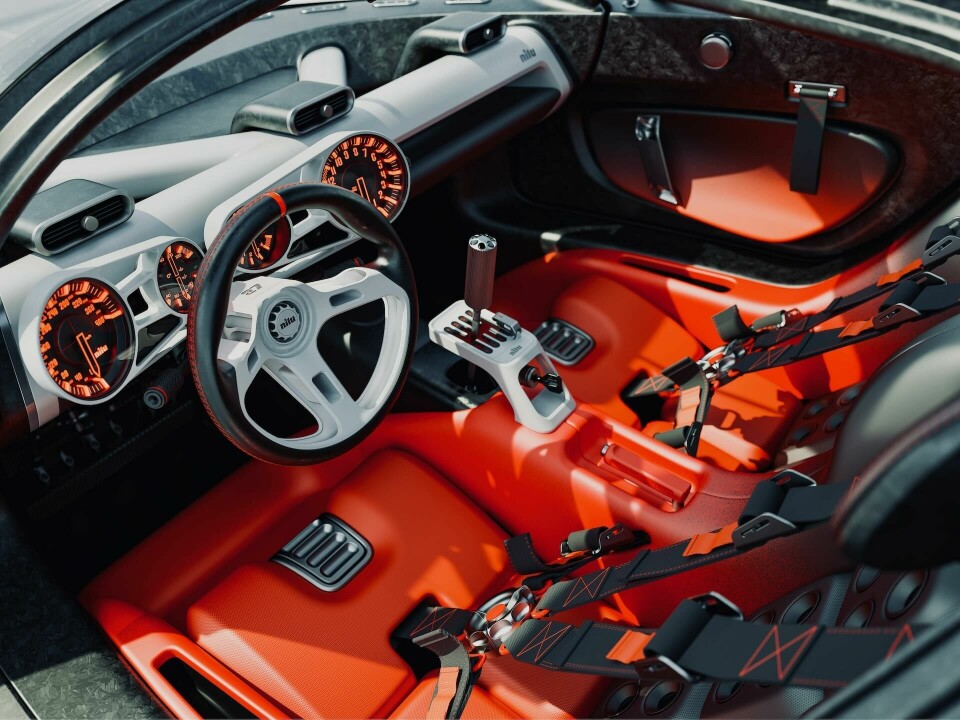
Interior Motives: Nilu27 – Analogue Purism
Sasha Selipanov realises his dream of creating a hypercar with a visceral driving experience
It is the dream of every designer to create their ’ultimate car’, one not constrained by corporate politics or the strictures of the legal, marketing or
accounting departments. Sasha Selipanov has done just that, creating a hypercar brand – Nilu27, referencing the racing number used by 1980s F1 drivers Gilles Villeneuve and Jean Alessi – and which is a pivot point in his career and one that boldly projects the future.
Selipanov has an excellent background for this project, with two decades of industry experience from brands including Bugatti, Lamborghini, Genesis and Koenigsegg. Indeed, he may be the most supremely qualified designer to undertake such a project and the result reflects his experience and vision.
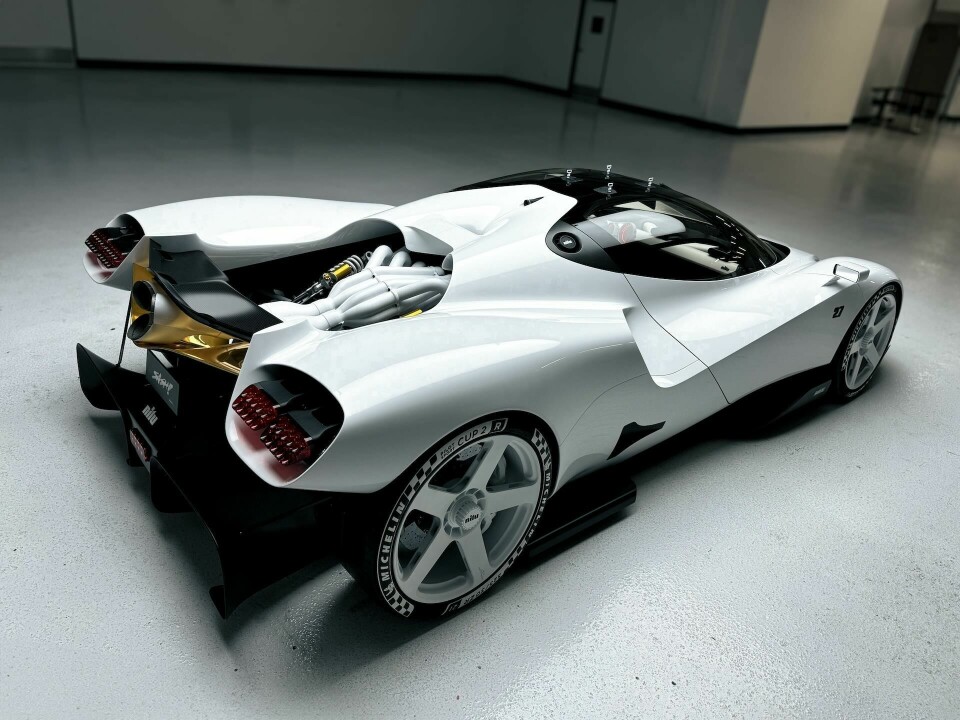
Selipanov’s first personal car from Nilu27 is called simply Nilu, a portmanteau of his daughters’ names (NIca and LUcia). It is, as Selipanov describes it, “the purest and most unfiltered representation of our company’s vision. It is a ‘manifesto’ for what we stand for as a brand and as a group of creative individuals.”
Technically speaking, the Nilu is a two-seat hypercar powered by a V12 engine and although our focus here is on the interior, it is worth taking a moment to review its impressive specifications. The engine is a 6.5-litre Hartley unit which peaks at 1070hp at 11,000rpm, with peak torque of 860NM at 7000rpm. The seven-speed manual transmission is by CIMA. The car rides on forged aluminum wheels, 20 inches at the front and 21 inches at the rear. These are shod with a set of Michelin Sport Cup R2 tyres. The dry weight is 1200kg. The top speed is 249mph (400kph).
Walking around the exterior of the Nilu, one can see visual cues of GT cars, hypercars and Le Mans prototypes of the past, although this is anything but a throwback or a resto-mod. It embraces the raw exhilaration of the classic racing and road touring classics of yesteryear, without copying their distinctive design expressions.
A Grand Entry, A Welcoming Seat
One of the underappreciated experiences in a premium car is the entry sequence. Whether a luxury sedan or a hypercar, the approach and entry is never just about opening the door. In the case of Nilu, this meant employing gull-wing doors. Selipanov explains: “The hypercar segment is often associated with theatre and drama. A lot of times companies choose to enhance this drama by coming up with elaborate door mechanisms. For us, simplicity and functionality is key. We believe that beauty and fascination emerge out of a perfectly-executed functional design.”
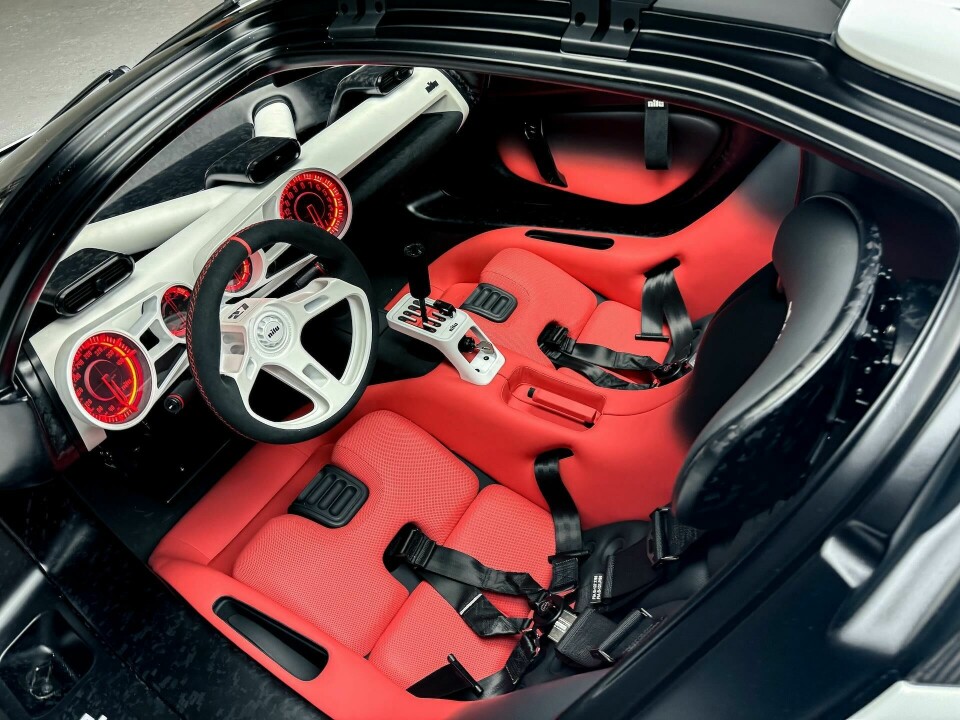
Ergonomic design was an acknowledgement of great hypercars of the past. Says Etienne Salome, interior designer and collaborator on Nilu: “These fixed seats are an homage to one of our favorite designs, the classic Ford GT Le Mans winner – the details of seat ventilation are an indication of that. We also looked at the Lamborghini Countach for the square seat pads.
“Our seats have been tirelessly reworked in order to achieve perfect ergonomics, to get the driver and passenger to sit comfortably, but to get them as low as possible as well. This is crucial for the overall dimensions and proportions of the vehicle. Also, the seat bolsters do not stick out from the sill and door flange. This makes it easier to slide in and out of the car; there’s no need to clear protruding obstructions.”
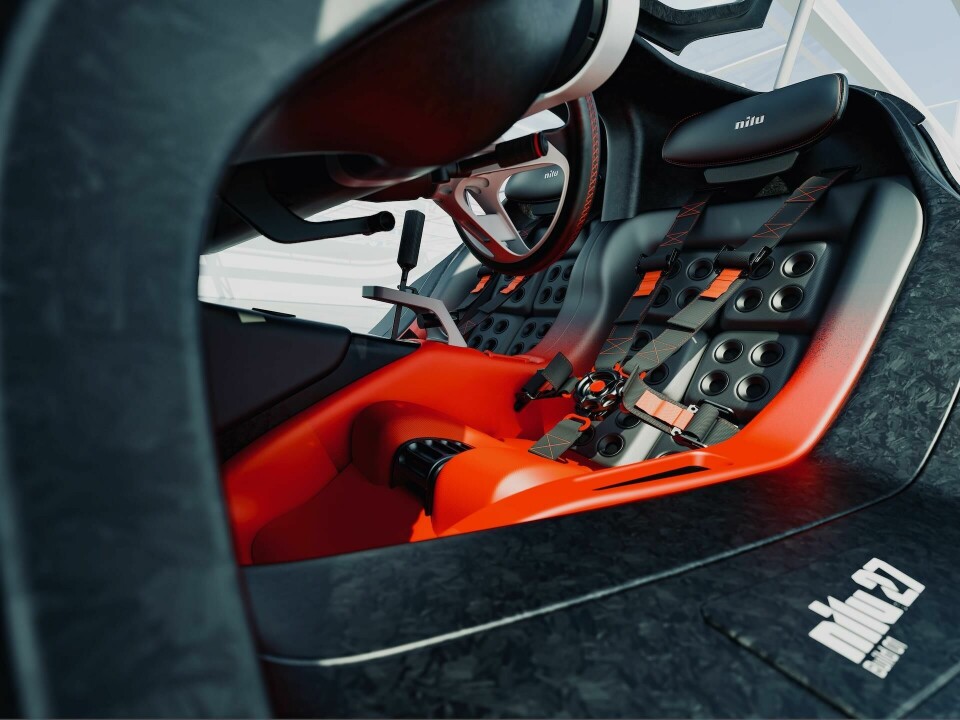
This being primarily a track car, one might be surprised that it is a two-seater. Again, from Salome: “The Nilu is all about the experience, but it is also about sharing the experience. The two-seat layout, side by side, also references the GT cars we love the most, creating healthy cabin proportions and an ideal experience for both the driver and the passenger.”
An Ignition Ritual
One of the primary visceral experiences is switching on the Nilu. “We believe starting a car is like a ritual, so it was important for us to design the sequence,” Salome continues. “First, you insert the key in the centre console – a real mechanical key – then proceed to the switches located on the headliner. The first one is called ‘ignition’ and gets the electricity running, the second is ‘pump’ which starts the fuel pump and gets the engine ready, and last but not least, is the ‘start’ switch which fires up the engine. Having worked through the ignition sequence, one’s attention is drawn to the steering wheel and the instrument panel. The steering wheel is shockingly plain – just a device to steer the car, no buttons or other distractions.”
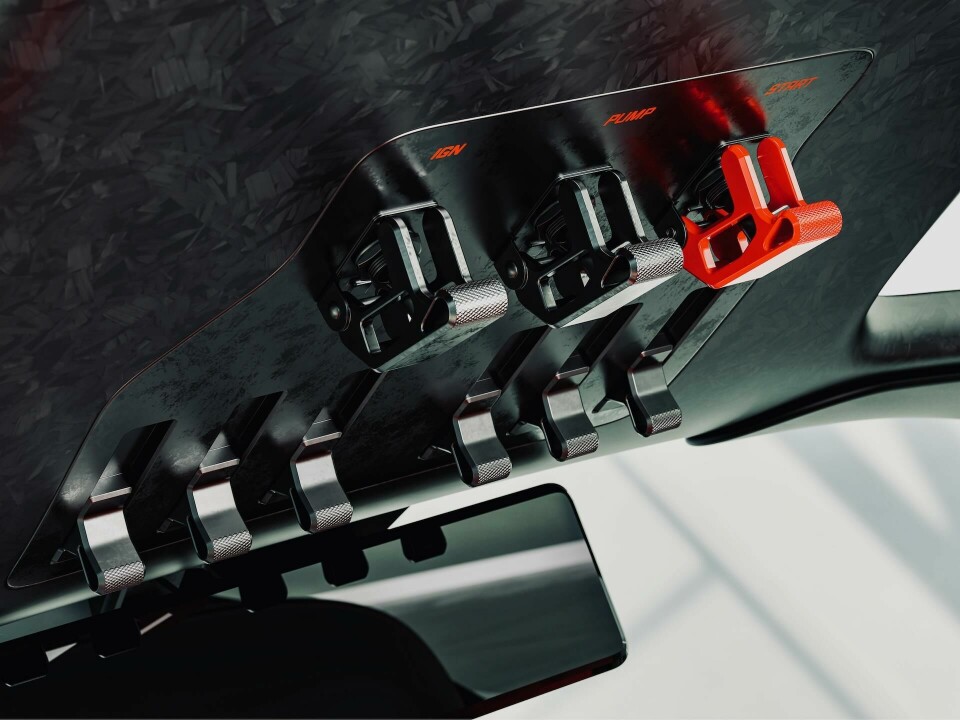
“The steering wheel is very important in the interior design”, explains Selipanov. “It is the first thing that the user looks at when entering the car and it is also all about proportions and ergonomics. The best steering wheels for us were the ones in early-90s F1. They were round and did not exceed 280mm in diameter.
“Our steering wheel is slightly larger at 315mm, but it is still far smaller than other wheels in the industry today. It is also perfectly round which means it is effortless to catch the car’s power slides and drifts. The small diameter is advantageous from the ingress and egress point of view too as it allows for less knee obstruction while at the same time also delivering a superior driving feel and precise information about the road.
Our steering wheel has no switches or controls, its only function is to point the vehicle in the right direction and to deliver the necessary information and confidence to the driver. It is also unique in terms of its manufacturing and design, taking inspiration from the car’s exterior rim design with its intricate metal machining which creates a solid wheel without adding weight. The result is a machined aluminum structure trimmed with Alcantara on the outside for grip.”
A Minimalist IP
Behind the steering wheel, the instrument panel is another exercise in functional minimalism. The principal element is the cross-beam, finished in white ceramic. Three snorkel-like projections rise from behind this bar, although around the Nilu studio they are called ‘lungs’.
“A performance car is all about weight reduction, so the IP design is reduced to the essentials”, says Salome. “The main element is the cross-car beam, which is totally exposed and has no external panels or cladding. This beam serves as our IP and is finished in white ceramic.
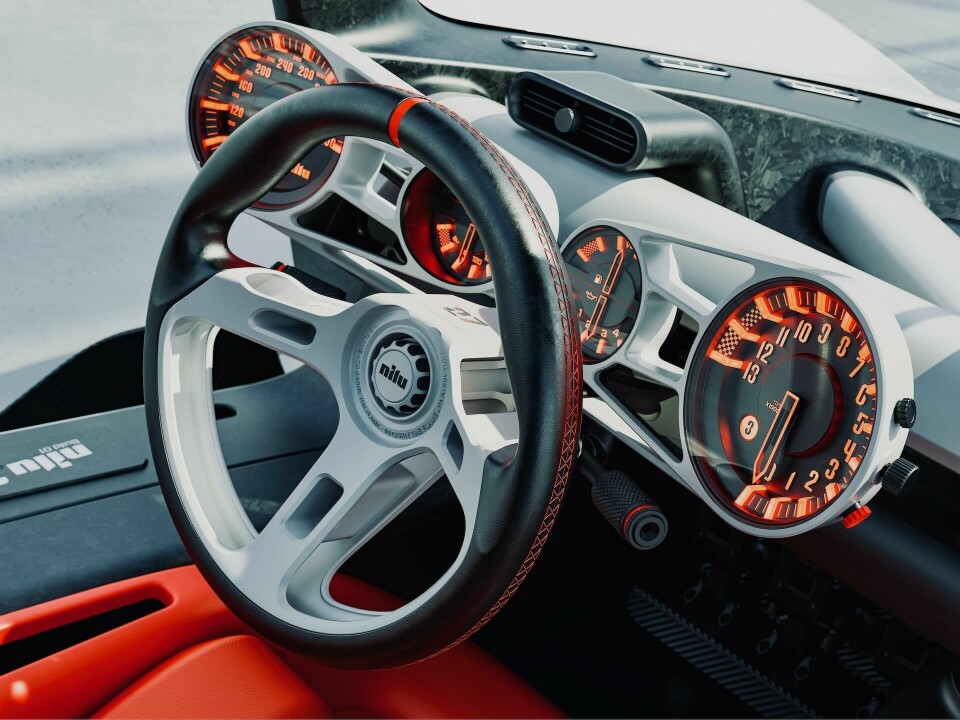
It is a structural element of the whole car and its shape reflects the rawness, nakedness and purity of our design approach. Carbon ‘lungs’ visible around the cross-car beam channel air from the HVAC unit to the top- mounted air vents and are mechanically adjustable for an optimal, refreshing air stream.” Flanking the steering wheel and slightly behind it are the instruments themselves, again a minimalist composition; only the essentials of performance are displayed for the driver.
“The small steering wheel results in a reduced field of view through its top section and only smaller dials could be used there”, says Salome. “So the only chance to display more information was to have bigger dials outside of the steering wheel. We took inspiration from classic cars like the Dino GT4 in order to create a cockpit feeling. It was also important for us to have a symmetrical layout, so the driver never doubts the straightness of the steering column and wheel. That’s why we created symmetrical dials, right and left from the steering wheel: one for the speed on the left side and one for engine revs on the right side.
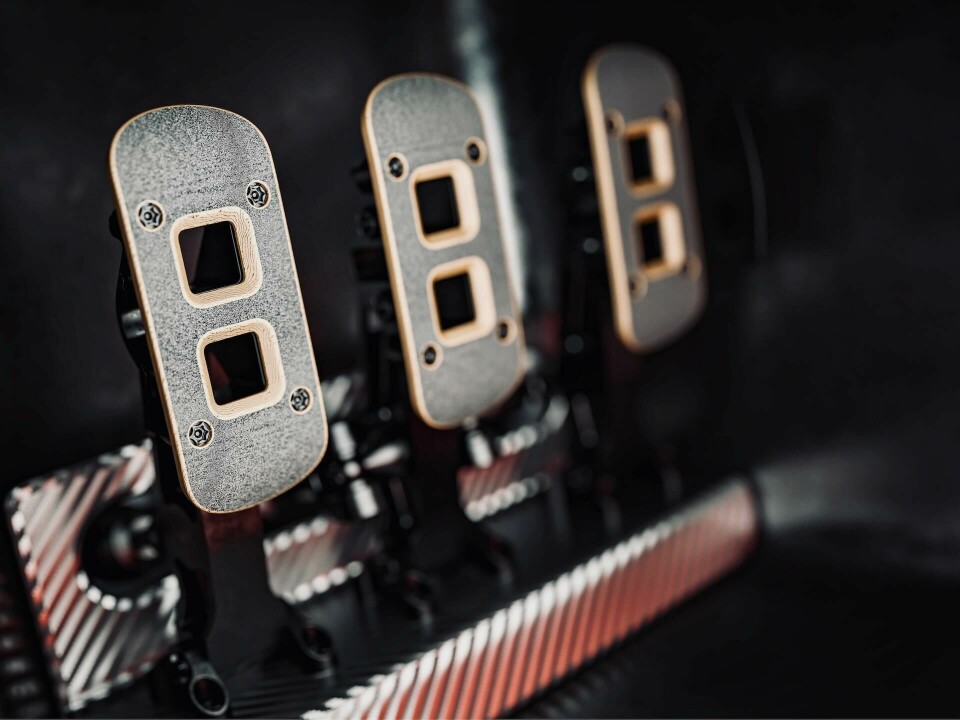
“The passion for detail is evident in the instruments however,” Salome continues, “the main focus being readability at speed, the clear design of the needles, bold and contrasted, making every gear change intuitive and reading information in a matter of milliseconds, so the driver can keep their eyes on the road.”
After assessing the instruments and placing one’s feet on the pedals (inspired by skateboards, made of plywood and covered with a textured metal foil for grip), one reaches for the gear shifter and discovers another ‘analogue’ bit of form and function. Selipanov explains: “Firstly, we wanted to position the shifter as close to the steering wheel as possible in order to minimise the amount of time and travel for the driver’s right hand.
Secondly, we wanted a very clear and easy to understand graphic layout for our H-pattern and hence decided to go with a so-called ‘open gate’ design. And the reverse slot is protected by a beautiful ‘lock-out’. Last, but not least, we wanted to enhance the feel and give the shifter a satisfying ‘throw’ so we used heavy iron-alloy inlays in the shifter’s tip. Just as with everything else on the Nilu, we followed functional reasons to arrive at an aesthetically-beautiful solution.”
The ‘beautiful solution’ continues in the selection of colours and fabrics in the Nilu, with seats covered in vegan leather and a bespoke ombré effect. “We designed a unique colour fade going through the seats and inner door panels,” says Salome. “It was created in order to prevent coloured reflections on the windscreen, which would have distracted the driver. This allowed for a very inviting, colourful and vibrant interior, all while keeping the driver focused on the road. We used vegan leather supplied by Von Holzhausen for our first build and will encourage our customers to follow environmentally-sustainable choices too.”
On the predominance of the colour white elsewhere, Selipanov explains: “As a world premiere for our hypercar brand we wanted to use the most crisp and clean colour palette. Of course, we also wanted to create something with great attitude and character. It was an interesting challenge to create a ‘badass’ look with white instead of the more traditional all-black approach. Our use of an accent colour (red in this case) is very controlled, purposeful. It is there to create a bit of warmth and ‘glow’ down below the waistline of the interior, while also accentuating the areas of functional significance.”
The “Holy Sh*t!” Factor
Summing it all up, Etienne Salome says: “The design of this interior is our vision of the hypercar future which, surprisingly, uses some of our oldest and most favourite recipes. Nilu manages to turn them into an ultra-modern design statement.”
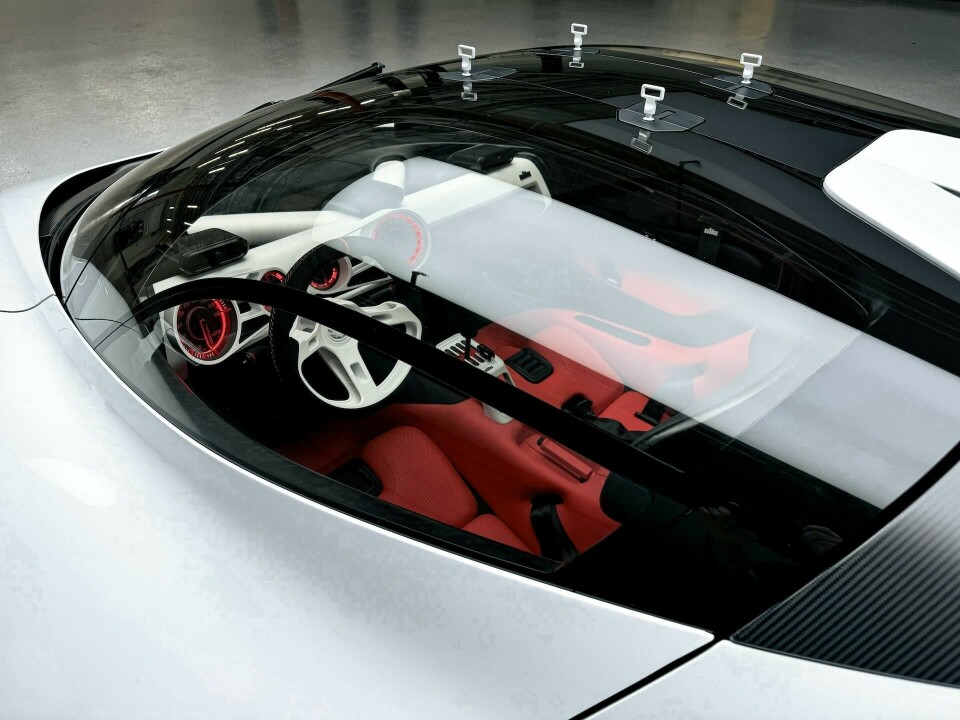
While Sasha Selipanov concludes like this: “The Nilu chooses to celebrate this raw unfiltered connection at the expense of some modern technology and convenience. We are going back to manual transmission, naturally-aspirated and an electrically unassisted drivetrain, all-mechanical human-machine interfaces (toggles, switches, buttons and dials instead of touchscreen and AI voice assistance) and of course, the long gone “Holy Sh*t!” Factor, which was so essential to the legends of the past.”









